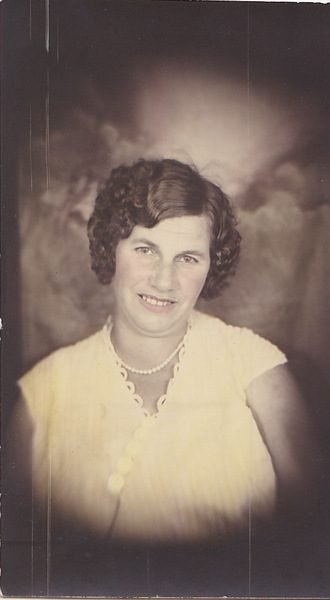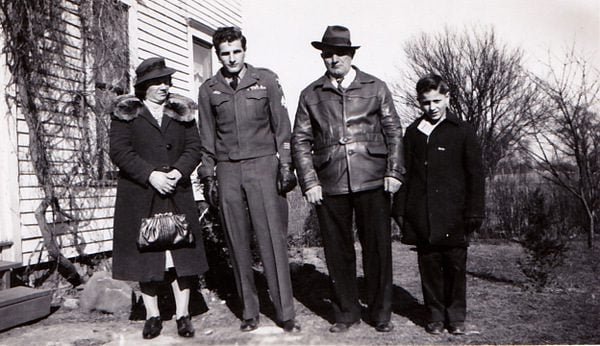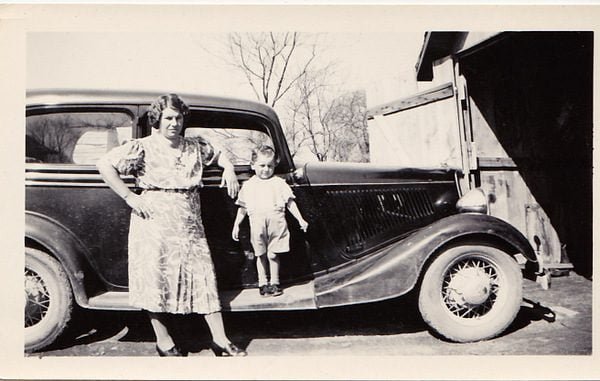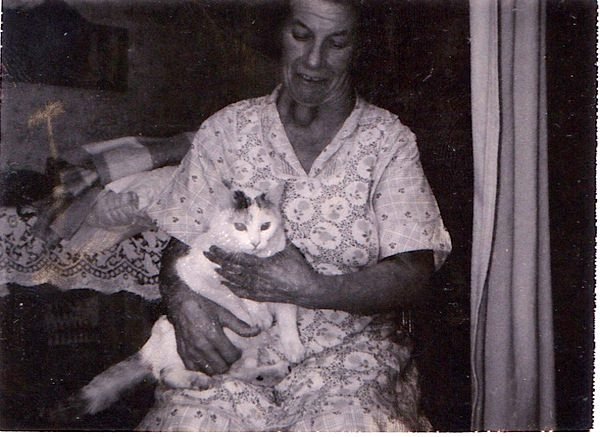
The Gerencser Family, circa 1950s Front: Robert (my Dad) and Irene Middle: Grandpa Paul Rear: Paul (Paulie), Grandma Mary, Mary, and Helen (As you can readily see, I look nothing like my dad and his family)
Dates and ages are approximate. My recollections are not what they once were. One reason for writing this post is to have a written record of these things before I someday can no longer remember them.
My grandparents immigrated from Hungary in the early part of the 20th century. I don’t know much about them. I was six years old when they died in 1963. Paul was born in 1888 and died of a heart attack in February of 1963. Mary, six years younger than her husband, died of a heart attack six weeks later.
Paul and Mary Nemett Gerencser (grr IN’ sir or grinsir) immigrated through Ellis Island and settled in Ohio. (I don’t think Paul and Mary were their given names.) They originally settled in the Akron/Cleveland area and then moved to Northwest Ohio. Best I can tell from what few official records remain, Paul and Mary Gerencser owned a farm in Defiance County, lost it during the Depression, and then bought a 100-acre farm in Williams County on the northwest corner of Williams County Road 14 and Williams-Defiance County Line Road. It was here I first met my grandparents and where they died.

Paul and Mary Gerencser had six children: Irene, Paul Jr, Steven, Helen, Mary, and Robert. Steven died in a farming accident (he fell off the tractor and was hit by a plow or disc) as a young boy. Irene died in 2009 at the age of 87. Paul (Paulie) died in 2012 at the age of 88. Marry died in 2018 at the age of 88. Robert, my father, died in 1987 at the age of 49. Helen is still living.
The Gerencser homestead was torn down decades ago. The new owners built a ranch home in its place. The old farmhouse was a white two-story structure. I do remember a few things about the house. There was an enclosed back porch and Grandma kept big sacks of flour and sugar on the porch. I also remember the wood-fired stove. I think there was a water pump at the kitchen sink. The house did not have indoor plumbing. There was an outhouse for necessary daily functions.

I do have a vivid memory of the creek that ran a few hundred yards from the back of the house. One year, Beaver Creek overran its banks, and floodwaters turned a portion of the low-lying farm ground into a lake. To a little boy, the flood water looked like a huge lake, but I am sure it was probably much smaller.
I don’t remember anything about my grandparents’ demeanor. I do remember they spoke Hungarian to each other. I don’t know if they spoke English at home. My father, aunts, and uncle, were schooled at the nearby one-room schoolhouse that sat on the southeast corner of Williams County Road 14 and US Highway 6. The one-room schoolhouse was torn down many years ago. My dad also went to school at Farmer, Ney, and Bryan. I do not know where any of my aunts or uncle attended school.

Paul and Mary Gerencser settled in northwest Ohio, Williams County because a number of Hungarian immigrants already lived here. Derek Harvey, a Toledo, Ohio man, wrote an interesting article about the Hungarians who settled in NW Ohio:
An important immigrant group to Toledo and Northwest Ohio were the people that came from the area in Central Europe known as the Magyars. This area stretched from Poland to the North to Belgrade in the southern region. The area would also encompass the large area known as Transylvania. (No Dracula jokes!) With the redrawing of borders after the first World War much would have been considered Hungary would have changed. Many large populations after this time would live in Romania, Slovakia and northern Yugoslavia. Some groups prior to World War 1 would be misidentified as Hungarians.
The largest group of this ethnic group 1.7 million came to the United States starting in 1880. Many would locate in the Birmingham neighborhood in Toledo. In 1900 there were almost 17,000 people living in Ohio that claimed this nationality. By 1920 the number would increase to 73,181. The primary group of immigration was males under the age of 30. Almost 90% of them were literate, but would take dangerous jobs that involved using their hands. This job areas in Toledo included automotive, glass and railroad industries. They tended to only come to the United States temporarily and over 50% would return to their homeland. Many would come back or just stay.
The religion of the Hungarians in Toledo was Catholic. Their home church in town St Stephen’s Catholic Church. The early population of this church was almost all Hungarian. This is a valuable place to check for church records for people of this nationality. The church was the center of their socialization activities. It would later become the center of their fraternal organizations. In Toledo a popular event was the Grape Harvest Festival and the Easter egg sprinkling. These groups and events played a important part of the assimilation of Hungarians into the fabric of Toledo. Family units in Hungarian early life extended beyond the immediate family. It was referred to as the “sib” and included aunts, uncles, cousins and godparents who might not be relatives.
A common practice after 1910 was for Hungarian families to take in recent immigrants primarily males. The husband and the boarders would work outside the home while the women would take care of the chores necessary for maintaining a household. The diet would lean towards meat and very few dairy, fruit or vegetables. Wonderful opportunities exist for more understanding of Hungarians genealogy. Great strides have taken place in many parts of the United States to get a better understanding of this group. There heritages are being preserved and new resources are being discovered daily.
From time to time I will run into local Hungarians who remember my dad or my aunts and uncle. Mary and Helen sang on the radio in the 1940s, and every so often someone will ask me if I am related to them. When someone notices my last name and asks me, are you related to ____________, the answer is always yes. All the Gerencsers in northwest Ohio are related to one another. I have second and third cousins in the Chicago, Benton Harbor Michigan, and Akron/Cleveland area whom I have never met. Locally, I have a few first and second cousins.

When Aunt Helen with Alzheimer’s was over at our house several years ago, she didn’t know who the woman in the picture above was, but she with delight said, oh, there’s my cat Pickles.
I am not certain what my grandparent’s religion was, but I suspect they were Catholics.
I regret not taking time to know my family history while those who could tell it to me were still alive. My dad died 35 years ago, and my grandparents died almost 60 years ago. Such is the lament of an old man. As death comes nearer and nearer to my door, I think more and more about the past. I wonder . . . what was it like for my dad to grow up on a farm? I will never be able to ask questions like this. Sometimes, when we drive down US 15/127 to Bryan, I gaze off to the left as we pass the Williams-Defiance County Line. I try to picture my grandparents, my dad, and my aunts and uncle, working the ground and taking care of the farm. I wonder about their hardships, about the hard work it took to eke out a living from the flat as an ironing board land of Williams County Ohio.
I have lots of questions…
I originally wrote this post eight years ago. Since then, I have learned that “Dad” was not my biological father; that my father was a truck driver who had a brief fling with my 17-year-old mother; that I have half brothers and sisters. Regardless, for good or ill, Robert Gerencser was my father. (Please see Questions: Bruce, How Was Your Relationship with Your Father?)
Bruce Gerencser, 66, lives in rural Northwest Ohio with his wife of 45 years. He and his wife have six grown children and thirteen grandchildren. Bruce pastored Evangelical churches for twenty-five years in Ohio, Texas, and Michigan. Bruce left the ministry in 2005, and in 2008 he left Christianity. Bruce is now a humanist and an atheist.
Connect with me on social media:
Your comments are welcome and appreciated. All first-time comments are moderated. Please read the commenting rules before commenting.
You can email Bruce via the Contact Form.

Know the feeling, my friend. I wish I knew my family history; I know absolutely nothing.
That’s quite a checkered past. Also love the pic of the 2 on that car from the 1930s. I’ve got similar pics of my homestead. Regardless. We’re here and that’s what counts.
Bruce,
Family history is always a good read. Thanks for being willing to share yours. Seeing your story and the pictures brings back many memories of my family as I am now approaching 50 years.
Funny family history story: for my whole life I was told and believed that I was part Cherokee. The story was that my great-great-grandfather secretly married a Cherokee woman in Missouri and quickly moved to Texas to avoid the fallout. The story explained the presence of the dark hair and ruddy-skin of my mother, aunt, and myself among a family of Scots-Irish toe-heads. It turns out you can’t outrun DNA. Genetic testing/geneology in the past few years has shown that I have no Cherokee DNA, at all. In fact, my DNA traces to the British Isles, exclusively. G-g-Grandpa had married his first cousin. The story was completely fabricated to avoid a shameful situation.
In the end, does it matter? Like you said, it is “for good or ill.” It’s not a value judgment, it just is.
Your recalling of your family farm, and their immigration, and everything reinforces in me the fact that like out DNA, we can’t escape our family and their influence on us. They made us who we are in large part. So much of our lives is our fight to break free of those chains… for good or ill. It’s always good to remember, however, if you can. If you cannot (Steve), I suppose that can be a blessing and a curse.
Good stuff.
Good to see your comment, Justin. Long time, no read. 🙂
Both sets of great grand parents on my mom’s side were Hungarian, although, there is some story that one grandfather was an “Austrian Jew”. One of my great grandmother’s also had numbers tattooed on her arm, but this was long before the nazi camps, so no one is quite sure why.
my husband just found out that his “dad” wasn’t his father. rather amusing when ancestry tests reveal such things.
My husband’s mother’s family weekend Hungarian immigrants who came through Ellis Island in the early 20th century, I think. They were well off enough that my mother-in-law has the family jewelry brought over from Hungary. They settled in Dutchess County, NY, about an hour drive north of NYC. The KKK burned a cross on their lawn – my mother-in-law says because they were Catholic immigrants, which is probably true because the KKK wouldn’t have considered Hungarian Catholics to be “white”. (Interestingly, my husband considers himself to be Irish-American because his father’s line is 100% Irish, they make a big deal of that heritage, and his mother is half Hungarian and half other European of indiscriminate origin).
I tell my kids that they have an interesting heritage with 20th century immigrants on their dad’s side and 17th century immigrants on mine. Good old USA melting pot.
My mother was English and my father Spanish. They met and married in Spain when my mother went to live there when she was studying for her degree (she was older then because of WW11 delaying her studies). I was born the following year in the north east of Spain, but moved back to England when I was nearly three when my parents split up (I never discovered the reason for this). My mother took me to live with my grandparents, together with my brother who was born in England within hours of my mother disembarking the ferry! We lived as this unit until I left home and got married in the 1970s.
Anyhow, the peculiar thing is my name. The names on my Spanish birth certificate bear no relationship to the names I now use. My Christian name on my birth certificate says ‘Wifredo’, but I’ve always been Geoffrey. I discovered this age 13 when I first needed official documentation to travel abroad with my school, and my mother told me that Wifredo is the Spanish equivalent of Geoffrey. I’ve discovered that she was telling porkies, and there is no connection between the names. I have a feeling that she started calling me Geoffrey to ingratiate herself with my grandparents, as her brother was called Geoffrey, and perhaps it helped in being able to go back and live with them. But my surnames fared little better. Under Spanish custom children take one surname from each of their parents and so have a hyphenated surname. So my surname on my birth certificate followed this practice, but when I moved to England my mother reverted to using my father’s other surname, not mentioned on the birth certificate! Don’t ask me why! Anyhow, I envisaged all sorts of problems when I first applied for an adult passport, and I couldn’t believe it when I was issued one without any queries whatsoever. So now I live under a permanent alias.
@GEOFFT
Actually, I looked up the etymology of Wifredo, and your mother wasn’t “talking porkies” Guifré is the Catalan version of Wilfredo. Both names mean “peace”. Congratulations, no alias required.
q.v. https://www.behindthename.com/name/wilfredo
Thanks Troy. That’s incredible! I really had researched that at length and never found it. Good grief!
I’ve just realised that I never investigated the Catalan origin, which is where I was born.
Family histories are always interesting to read, indeed. But they are not always for the faint of heart.
Example: When I was about 30, my mother was going through some family papers–for what reason, I forget. Anyway, that day she glanced at my father’s birth certificate and noticed something that she hadn’t seen before: The birth date for my grandmother was about 20 years earlier than her actual birth date. My mother questioned him about that.
Well, we always thought it curious that his parents were in their late 40s when my father was born. In the late 1930s, that was even more unusual than it is today. Turns out, something we always knew about my grandfather came into play: He was a player. So, my father said, he believes that birth date was that of the woman who actually gave birth to my father. He thought it might have been one of his estranged relatives.
Oh, and it helped to confirm something that everyone else in the family had long suspected. I’ll put it delicately: My grandfather didn’t emigrate to the US because of his political or religious principles. He was yearning to be free, all right–free of the carbineri or the fathers of girls in his village, depending on whom we believe.
Anyway, my mother and I (and the rest of my family) wished we’d known, in part because we want to know family history, but also because it helped to explain why my father could be so emotionally distant. He was clearly ashamed–without reason, I believe, for I believe people should be ashamed of what they come from, or any other circumstance over which they have no control.
Today he laments that he could have been a better father and husband. That’s probably true, but given his background, he could have been much worse.